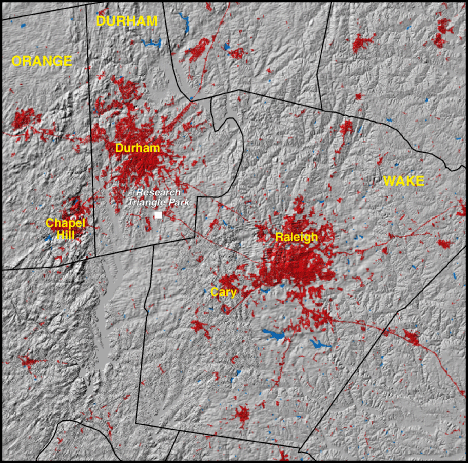Raleigh-Durham, North Carolina 1973


|
1970 Population - 419,254
Includes Wake, Durham, and Orange Counties. NOTE: portions of the above listed counties may not be visible on the map Red areas shown as developed land 92,000 acres (144 square miles) |
Raleigh was founded in 1792 as North Carolina's capital because of its centralized location. Durham evolved from a railroad station in the 1850s. Raleigh grew after 1870 as a trade center. The founding of North Carolina State University in the city also spurred growth. Durham developed as an industrial town, specializing in tobacco and textiles. The Durham vicinity also had educational institutions, including Trinity College (later Duke University) in the city itself and the University of North Carolina in nearby Chapel Hill. The regional location of all these universities and State development funding led to the creation of the Research Triangle Park in the 1950s. |
Raleigh-Durham, North Carolina 1992

|
1990 Population - 702,006
Includes Wake, Durham, and Orange Counties. NOTE: portions of the above listed counties may not be visible on the map Red areas shown as developed land 142,000 acres (222 square miles) |
Located between the two cities, the Triangle became a magnet for technology-oriented corporations and government facilities. With urbanization have come growth-related problems. Raleigh has expanded mostly to the north, resulting in increasing traffic congestion. The hilly terrain around much of the city has influenced infrastructure development and thus an uneven concentration of growth. The local topography also enabled the creation of new reservoirs on local rivers for urban water supplies, but their construction raised concerns over the loss of riparian habitat in the area. |